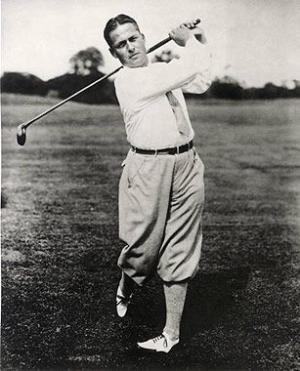Bobby Jones ( )

Bobby Jones
Hall of Fame Golfer. Though his career was brief, and while he competed as an amateur, he is considered by many to have been the greatest practitioner of his game that ever lived. Born to a distinguished family of wealth and position, he was a child prodigy in golf and was instructed by Scottish professional Stewart Maiden. He started entering junior tournaments at age six, at 14 made it to the third round of the U.S. Amateur, and at 16 captured his first significant title when he won the Georgia State Amateur. Though in his adult years Mr. Jones was a model “Southern Gentleman”, in his younger days he was afflicted with a severe ill-temper that was manifested by club-throwing and foul language that often embarrassed himself and his family. Though he completely conquered his tempermental outbursts he never was able to get over the emotional stress reaction he had to competition, a condition which perhaps contributed to his early retirement. Mr. Jones won the Southern Amateur in 1917, 1920, and 1922, joined Alexa Stirling and others in giving exhibitions during World War I, and competed in his first U.S. Open in 1920. His first “major” title came when he won the 1923 U.S. Open in a playoff with Bobby Cruickshank and began a seven year dominance of the game that saw him capture 13 majors in 20 attempts while five times resresenting the United States in the Walker Cup. He repeated his U.S. Open victory in 1926, 1929, and 1930, took the British Open in 1926, 1927, and 1930, was the U.S. Amateur champion in 1924, 1925, 1927, 1928, and 1930, and in 1930 captured his only British Amateur title to complete the legendary and never duplicated Grand Slam of four major titles in the same year. Mr. Jones was honored with the AAU’s first annual Sullivan Award but then stunned the world by announcing his retirement from competitive golf. During his playing days he had gotten his education, earning degrees in engineering from Georgia Tech and in literature from Harvard and passing the Georgia Bar after a single year at Emory University Law School. Bobby Jones joined his father’s legal practice and in a twist turned professional, making a series of golf instructional films which featured Hollywood stars of the day and working for Spalding in golf club design. He was supremely qualified for his job with Spalding; while his putter “Calamity Jane” with three strips of tape on the shaft is the most famous golf club of all time, his touch with the other instruments of the game was phenominal. During Mr. Jones’ day clubs were often acquired singly and the concept of swing weight matching was unknown; years later his clubs were placed on a swing weight scale and found to be perfectly matched save for the eight iron, the one club that he was to recall giving him the most trouble. In 1931 he partnered with New York investment banker Clifford Roberts to buy the plot of ground that was to be opened as his self-designed Augusta National Golf Club in 1933, then innaugurated the Masters Tournament in 1934. He was to play in the tournament every year up to 1948 and though his game was no longer in shape to compete at an elite level he still made respectable showings. During World War II he served as a Lieutenant Colonel in the U.S. Army Air Corps while allowing the Army to graze cattle at Augusta National. After the conflict he remained active in business and continued to play golf with friends but by 1948 he was experiencing severe back pain every time he swung a club. Mr. Jones was diagnosed with syringomylia, a cystic cavity within the spinal cord that was to lead to progressive disability and eventually to confine him to a wheelchair. Despite his steadily deteriorating health he continued to host the Masters every year; he died from an accumulation of chronic problems and was baptized into the Catholic Church on his deathbed. Elected to the World Golf Hall of Fame in 1974, today he remains part of American folklore; while the Masters Tournament is, of course, his most visible legacy, commuters in Augusta travel the Bobby Jones Expressway, Emory University and Scotland’s St. Andrews University present scholarships in his honor, and the USGA’s sportsmanship award carries his name. Mr. Jones was depicted on an 18 cent postage stamp, is the subject of a number of books, and has been brought to life on the silver screen at least twice, by Joel Gretsch in 2000’s “The Legend of Bagger Vance”, a fantasy partially based on his exhibition matches with Walter Hagen, and by James Caviezel in the 2004 box office flop “Bobby Jones: Stroke of Genius”. Named the fourth greatest golfer of all time by “Golf Digest” behind Nicklaus, Snead, and Hogan, he still gives instruction via the films he made and the several books he authored. At this distance in time one may question whether he ever truly enjoyed the game that made him a legend as of the pressures of tournament play he said: “It is something like a cage. First you are expected to get into it and then you are expected to stay there. But of course, nobody can stay there”.
Born
- March, 17, 1902
- Atlanta, Georgia
Died
- December, 18, 1971
- Atlanta, Georgia
Cemetery
- Oakland Cemetery
- Atlanta, Georgia



